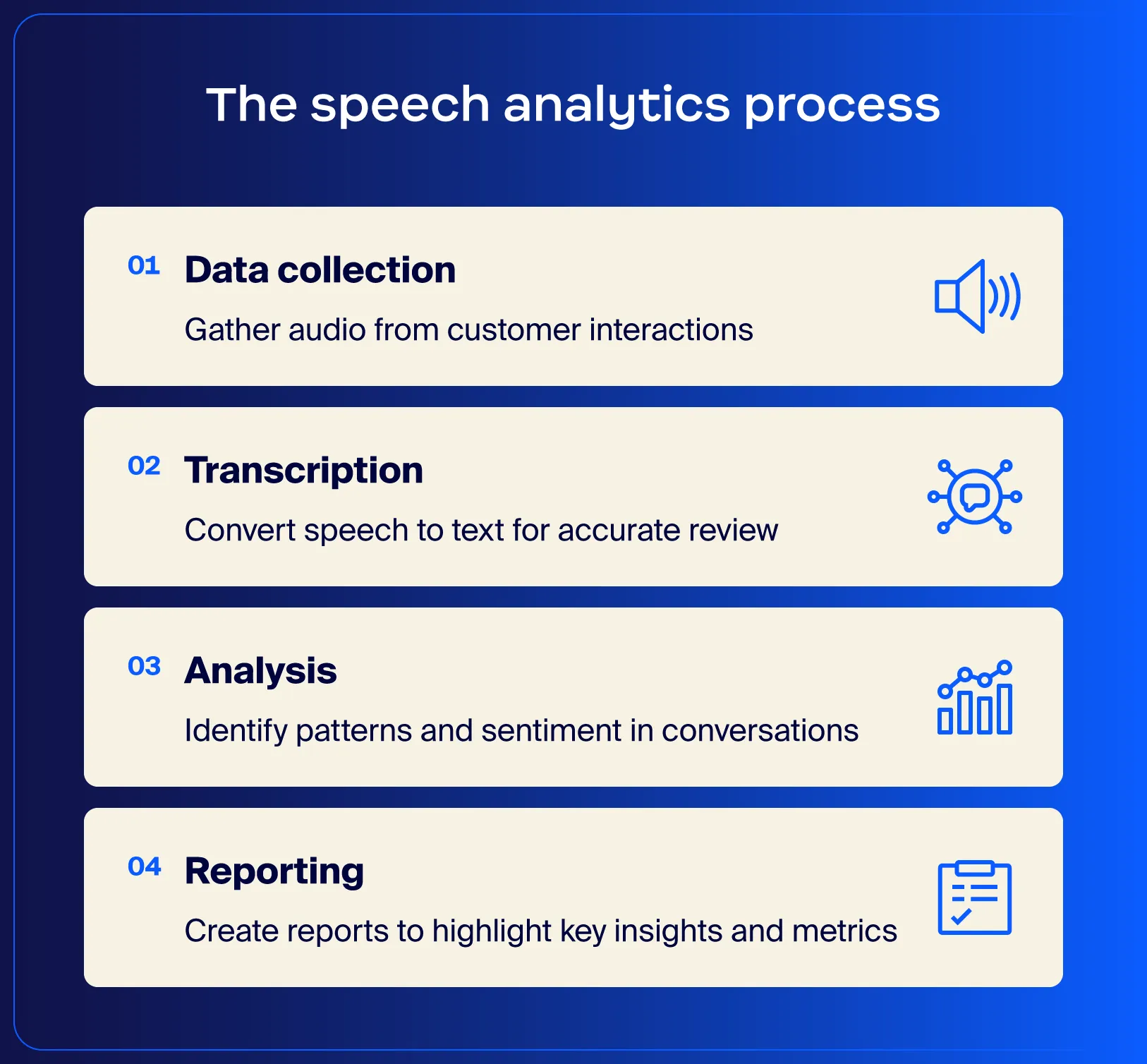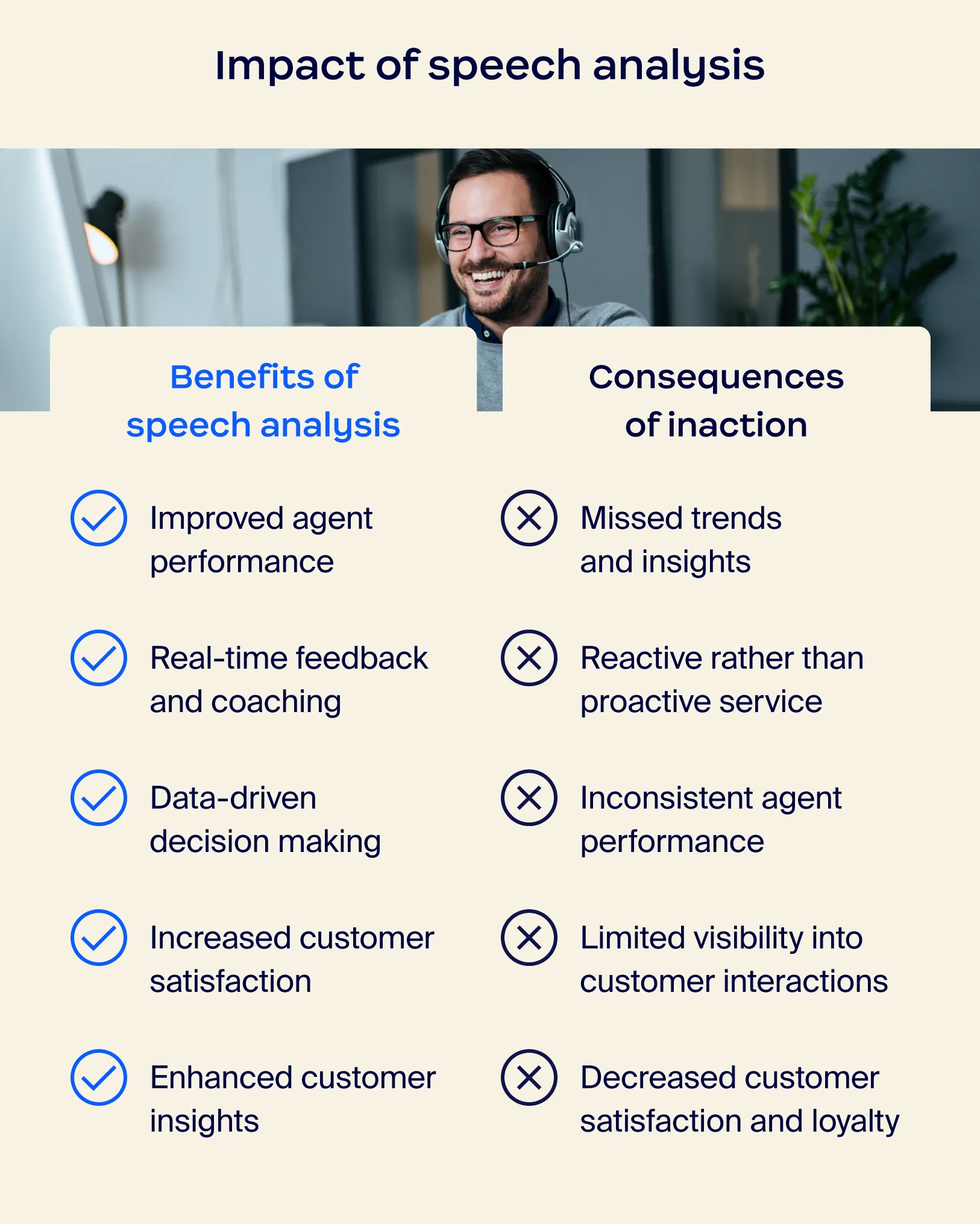
Meet Zoom AI Companion, your new AI assistant!
Boost productivity and team collaboration with Zoom AI Companion, available at no additional cost with eligible paid Zoom plans.
Updated on February 20, 2025
Published on February 20, 2025


Every interaction in a contact center is a gold mine of customer insights — but are you really tapping into it? With thousands of conversations happening daily, it’s nearly impossible for human agents to capture every nuance. This is where speech analytics steps in, transforming raw voice data into actionable insights in real-time. By automatically analyzing call content, identifying trends, and even detecting customer sentiment, speech analytics empowers businesses to turn routine interactions into opportunities for growth.
In this blog, we’ll cover what speech analytics is, how it works, key use cases, and what to look for when choosing a solution.
Speech analytics is a technology that allows organizations to analyze and interpret spoken language from customer interactions. It captures audio from phone calls and uses algorithms such as hidden Markov models (HMM) and natural language processing (NLP) to transcribe spoken words into text.
This process enables businesses to extract important information about customer sentiments, behaviors, and preferences, helping to inform service improvement strategies. After transcription, machine learning techniques analyze the text for keywords and phrases, flagging key topics like product inquiries or complaints.
Sentiment analysis evaluates the tone and emotional context of conversations, providing insights into customer satisfaction. By converting spoken interactions into structured data, organizations can identify trends, work towards meeting compliance requirements, and target areas for agent improvement, ultimately enhancing contact center performance and addressing customer needs effectively.
Speech analytics involves a series of systematic steps that transform audio from customer interactions into valuable insights. Below, we detail the key processes involved, including audio capture, transcription, data analysis, and sentiment assessment.
Data collection is the foundation of speech analytics, where customer conversations are recorded and captured for analysis. This process typically occurs during interactions over phone calls, but it can also include recordings from voice channels in digital communication platforms.
Using sophisticated call center software, organizations can automatically record conversations with customers so that relevant interactions are captured without requiring manual intervention. This comprehensive approach makes data from various customer touchpoints readily available for subsequent analysis.
For example, consider a customer service center that handles inquiries about a telecommunications service. When a customer calls to ask about their bill, the conversation is automatically recorded by the call center software. This recorded data is stored securely and becomes part of the larger dataset for analysis.
The next step in speech analytics is transcription, which involves converting recorded audio into precise written text. This process employs advanced speech recognition technologies that utilize algorithms and machine learning models for high accuracy in transcribing spoken language. By transforming audio into text format, organizations can facilitate comprehensive analysis of customer interactions and derive actionable insights.
For instance, let’s say a customer calls tech support to report a recurring error message in a software application. After the audio is recorded during data collection, the automated transcription process captures the entire conversation, converting it into a detailed text format.
This accuracy allows the software company to pinpoint frequently mentioned phrases and issues, enabling them to develop targeted troubleshooting guides and improve knowledge base articles.
The analysis step in speech analytics leverages AI and advanced algorithms to identify keywords, sentiment, and patterns within the transcribed text. Using NLP techniques, these algorithms scan the text for specific terms and phrases that indicate customer intent, sentiment, or areas of concern. This process allows organizations to categorize interactions based on topics, such as product inquiries, complaints, or support requests, providing a clear overview of customer interactions.
For example, a customer service team at a software company might analyze conversations to understand customer sentiment regarding a recent product update. By running the transcriptions through sentiment analysis algorithms, the team can gauge whether feedback is predominantly positive, negative, or neutral. If the analysis reveals a high frequency of negative sentiments associated with a particular feature, the company can prioritize addressing that issue in future updates.
The final step in speech analytics is reporting, where the insights derived from the analysis are transformed into actionable data. Reports typically summarize key findings, such as the frequency of specific keywords, customer sentiment trends, agent performance metrics, and compliance tracking. Recent innovations in contact center AI can help make reporting a faster process while generating more thorough insights.
For example, a contact center manager may review a dashboard showing that calls related to billing issues have increased by 15% in the past month, with a corresponding rise in negative sentiment. The report might also show that Agent A consistently resolves these calls faster than others.
Equipped with this data, the manager can focus on resolving the billing issue, assign additional training to improve agent performance, and replicate best practices from Agent A and other top performers.

Speech analytics offers multiple advantages for contact centers, enhancing everything from customer experience to operational efficiency. This section explores key use cases that demonstrate how speech analytics helps drive better outcomes for contact centers.
Understanding what customers need and how they feel is one of the main components of delivering great service. Speech analytics helps contact centers tap into customer emotions and spot recurring issues as they happen so they can be addressed quickly.
For instance, a telecom company might use speech analytics to detect frustration during calls about network outages. With that insight, they can offer faster solutions or compensation, making customers feel heard and valued and improving overall satisfaction.
Providing agents with objective feedback is crucial for helping them improve how they handle calls. Speech analytics is one of the best ways to use AI to enhance customer support and get data-driven insights into agent performance, from communication style to how effectively they resolve issues.
For example, a customer service team could use speech analytics to track how often an agent interrupts a caller or how well they follow scripts. By identifying these patterns, managers can offer targeted coaching that boosts agent effectiveness and customer satisfaction.
In highly regulated industries like finance, healthcare, and insurance, maintaining compliance is critical. Speech analytics can help companies by automatically monitoring conversations for required legal disclosures, script adherence, and regulatory guidelines.
For example, a healthcare provider might use speech analytics to support compliance with HIPAA regulations by monitoring agent responses during patient calls. The system flags conversations where agents may accidentally share patient information with unauthorized individuals, such as a third party or other patients on a group call. This helps prevent future violations, helping to ensure sensitive data is only shared with the intended recipient, protecting privacy and avoiding potential fines.
Speech analytics is essential for extracting valuable insights — such as identifying trends in customer inquiries, measuring customer satisfaction levels, and assessing agent performance — that help optimize contact center operations. By analyzing customer interactions, organizations can identify trends, gauge customer sentiment, and pinpoint areas for improvement.
For example, a SaaS company might discover through speech analytics that a significant number of calls are related to onboarding issues with their software. This insight might prompt the company to enhance its onboarding materials and training resources, leading to a smoother user experience and reduced support calls, ultimately driving customer satisfaction and retention.
Speech analytics can significantly reduce costs for your contact center by automating time-consuming tasks like call transcription and identifying trends in customer dissatisfaction. By efficiently analyzing calls, organizations can pinpoint common issues, allowing them to implement solutions that minimize repetitive inquiries. This automation frees up agents to focus on complex customer issues, leading to faster resolutions and improved service.
For example, a telecom company might use speech analytics to identify that a large volume of calls is related to billing disputes. By analyzing these interactions, they can implement better online self-service options for billing inquiries. This reduction in call volume not only decreases the need for agent involvement but can also cut operational costs associated with handling routine inquiries.

When evaluating options, consider the following key characteristics to select a robust and effective tool that delivers tangible benefits:
By leveraging AI-powered speech analytics, Zoom Contact Center empowers businesses to gain valuable insights from customer interactions, automate processes, and enhance overall customer experience.
With AI-first features like automatic call transcription, sentiment analysis, quality monitoring, and agent coaching, Zoom Contact Center helps businesses overcome pain points such as manual analysis, limited insights, and difficulty in identifying areas for improvement.
Contact us today, and a CX expert will show you how Zoom Contact Center can elevate your customer service.
If you have lingering questions about speech analytics, we answer a few common questions below. Understanding these key concepts will enable you to leverage speech analytics more effectively in your contact center operations.
Speech analytics is primarily used to analyze recorded calls and live conversations to extract valuable insights about customer interactions. It allows organizations to identify trends, monitor agent performance, and enhance customer satisfaction by uncovering the underlying reasons behind customer inquiries and complaints. By analyzing this data, businesses can make informed decisions that improve service delivery and overall operational efficiency.
While the terms “speech analytics” and “voice analytics” are often used interchangeably, there is a subtle difference between the two. Speech analytics focuses on analyzing the content of spoken language to derive insights, such as identifying keywords, phrases, and sentiments. In contrast, voice analytics typically refers to the analysis of audio characteristics, such as tone, pitch, and volume, which can provide insights into the speaker’s emotional state. Together, these analytics types help offer a comprehensive understanding of customer interactions.
Key features of speech analysis include transcription accuracy, real-time analytics, sentiment analysis, and keyword spotting. These tools allow organizations to not only convert speech to text but also assess the emotional tone of conversations and track specific terms or phrases of interest. Additionally, advanced AI-powered reporting capabilities enable businesses to visualize data trends and monitor agent performance, ultimately driving continuous improvement in customer service strategies.